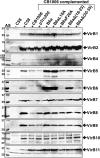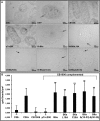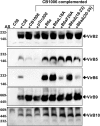Interaction via the N terminus of the type IV secretion system (T4SS) protein VirB6 with VirB10 is required for VirB2 and VirB5 incorporation into T-pili and for T4SS function
- PMID: 29976757
- PMCID: PMC6120205
- DOI: 10.1074/jbc.RA118.002751
Interaction via the N terminus of the type IV secretion system (T4SS) protein VirB6 with VirB10 is required for VirB2 and VirB5 incorporation into T-pili and for T4SS function
Abstract
Many bacterial pathogens employ multicomponent protein complexes such as type IV secretion systems (T4SSs) to transfer virulence factors into host cells. Here we studied the interaction between two essential T4SS components: the very hydrophobic inner membrane protein VirB6, which may be a component of the translocation channel, and VirB10, which links the inner and outer bacterial membranes. To map the interaction site between these two T4SS components, we conducted alanine scanning and deleted six-amino acid stretches from the N-terminal periplasmic domain of VirB6 from Brucella suis Using the bacterial two-hybrid system to analyze the effects of these alterations on the VirB6-VirB10 interaction, we identified the amino acid regions 16-21 and 28-33 and Leu-18 in VirB6 as being required for this interaction. SDS-PAGE coupled with Western blotting of cell lysates and native PAGE of detergent-extracted membrane proteins revealed that the corresponding VirB6 residues in Agrobacterium tumefaciens (Phe-20 and amino acids 18-23 and 30-35) modulate the stability of both VirB6 and VirB5. However, the results from immuno-EM and super-resolution microscopy suggested that these regions and residues are not required for membrane association or for polar localization of VirB6. The six-amino acid deletions in the N terminus of VirB6 abolished pilus formation and virulence of A. tumefaciens, and the corresponding deletions in the VirB6 homolog TraD from the plasmid pKM101-T4SS abrogated plasmid transfer. Our results indicate that specific residues of the VirB6 N-terminal domain are required for VirB6 stabilization, its interaction with VirB10, and the incorporation of VirB2 and VirB5 into T-pili.
Keywords: Agrobacterium tumefaciens; T-pilus; bacteria; bacterial pathogenesis; membrane protein; protein secretion; protein–protein interaction; type IV secretion system; virulence; virulence factor.
© 2018 Mary et al.
Conflict of interest statement
The authors declare that they have no conflicts of interest with the contents of this article
Figures










Similar articles
-
Structural Analysis and Inhibition of TraE from the pKM101 Type IV Secretion System.J Biol Chem. 2016 Nov 4;291(45):23817-23829. doi: 10.1074/jbc.M116.753327. Epub 2016 Sep 15. J Biol Chem. 2016. PMID: 27634044 Free PMC article.
-
Molecular characterization of the Agrobacterium tumefaciens DNA transfer protein VirB6.Microbiology (Reading). 2005 Nov;151(Pt 11):3483-3492. doi: 10.1099/mic.0.28337-0. Microbiology (Reading). 2005. PMID: 16272372
-
Membrane and core periplasmic Agrobacterium tumefaciens virulence Type IV secretion system components localize to multiple sites around the bacterial perimeter during lateral attachment to plant cells.mBio. 2011 Oct 25;2(6):e00218-11. doi: 10.1128/mBio.00218-11. Print 2011. mBio. 2011. PMID: 22027007 Free PMC article.
-
The Agrobacterium VirB/VirD4 T4SS: Mechanism and Architecture Defined Through In Vivo Mutagenesis and Chimeric Systems.Curr Top Microbiol Immunol. 2018;418:233-260. doi: 10.1007/82_2018_94. Curr Top Microbiol Immunol. 2018. PMID: 29808338 Free PMC article. Review.
-
Bases moléculaires de l’infection de plantes par Agrobacterium tumefaciens via un système de sécrétion de type IV 1.Biochem Cell Biol. 2019 Jun;97(3):215-223. doi: 10.1139/bcb-2018-0160. Epub 2018 Aug 24. Biochem Cell Biol. 2019. PMID: 30142282 Review. French.
Cited by
-
Transcriptomic Analysis of the Negative Effect of Epigallocatechin-3-Gallate from Tea Plant (Camellia sinensis) on Agrobacterium-Mediated Transformation Efficiency.Curr Issues Mol Biol. 2025 Mar 8;47(3):178. doi: 10.3390/cimb47030178. Curr Issues Mol Biol. 2025. PMID: 40136432 Free PMC article.
-
Inner membrane components of the plasmid pKM101 type IV secretion system TraE and TraD are DNA-binding proteins.Sci Rep. 2025 Mar 4;15(1):7530. doi: 10.1038/s41598-025-85446-9. Sci Rep. 2025. PMID: 40032854 Free PMC article.
-
Cryo-EM structure of a conjugative type IV secretion system suggests a molecular switch regulating pilus biogenesis.EMBO J. 2024 Aug;43(15):3287-3306. doi: 10.1038/s44318-024-00135-z. Epub 2024 Jun 17. EMBO J. 2024. PMID: 38886579 Free PMC article.
-
Comparative Genomic Analysis Confirms Five Genetic Populations of the Select Agent, Rathayibacter toxicus.Microorganisms. 2020 Mar 5;8(3):366. doi: 10.3390/microorganisms8030366. Microorganisms. 2020. PMID: 32150860 Free PMC article.
-
VirB11, a traffic ATPase, mediated flagella assembly and type IV pilus morphogenesis to control the motility and virulence of Xanthomonas albilineans.Mol Plant Pathol. 2024 Sep;25(9):e70001. doi: 10.1111/mpp.70001. Mol Plant Pathol. 2024. PMID: 39223938 Free PMC article.
References
Publication types
MeSH terms
Substances
Grants and funding
LinkOut - more resources
Full Text Sources
Other Literature Sources

